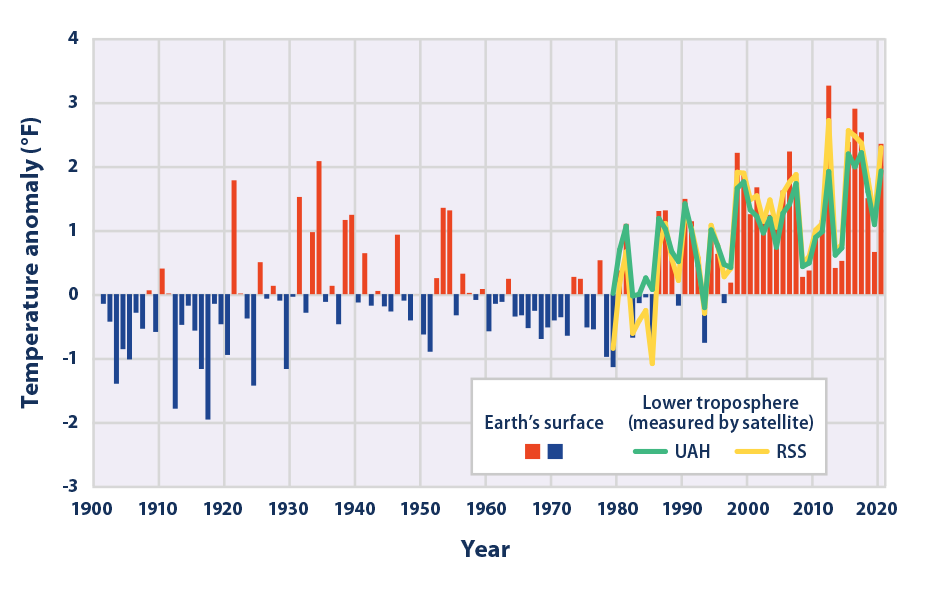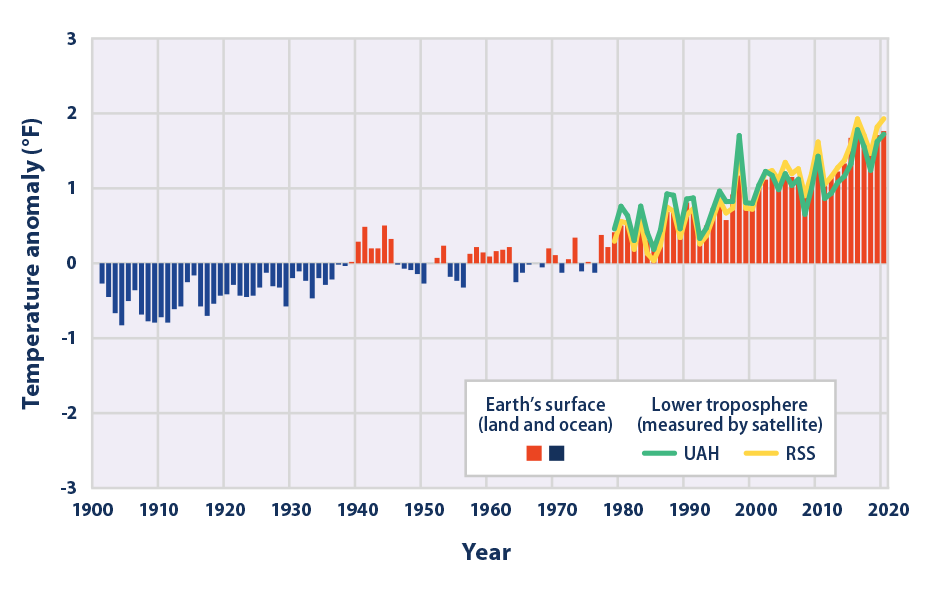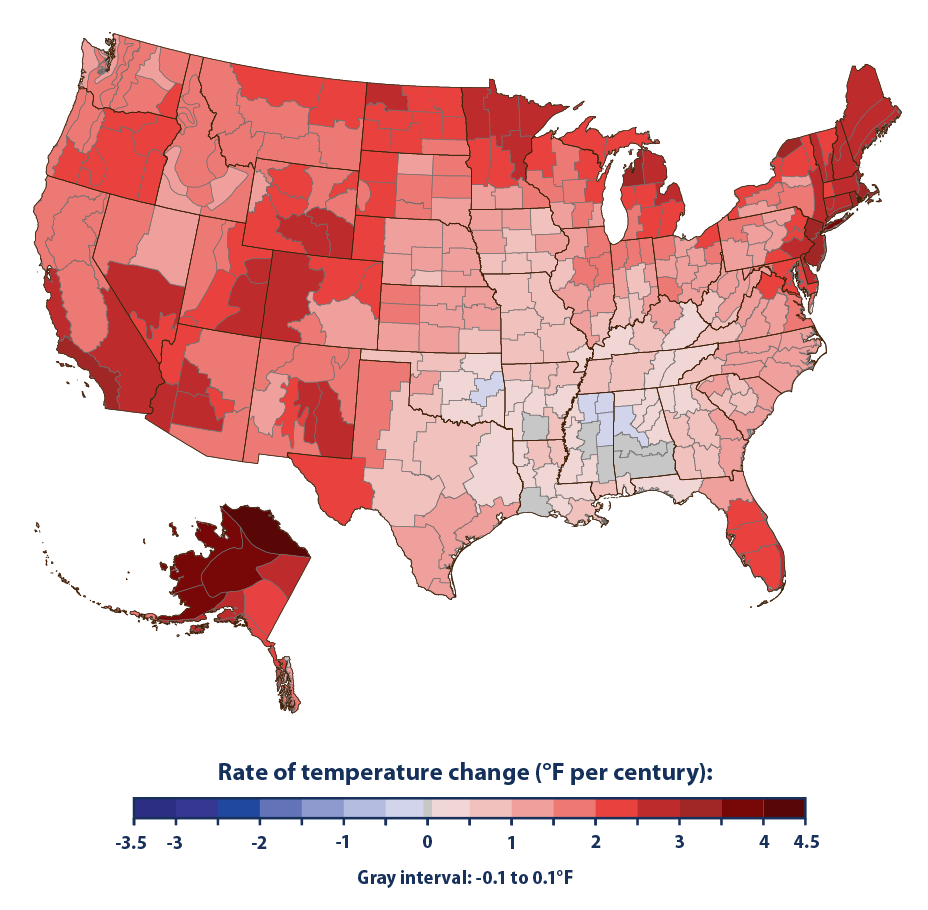What equipment is used to collect weather data in the troposphere?
This indicator describes trends in average surface temperature for the United States and the world.
-

This figure shows how almanac boilerplate temperatures in the contiguous 48 states have changed since 1901. Surface information come from land-based weather stations. Satellite measurements cover the lower troposphere, which is the lowest level of the Globe's temper. "UAH" and "RSS" correspond two unlike methods of analyzing the original satellite measurements. This graph uses the 1901–2000 average every bit a baseline for depicting change. Choosing a dissimilar baseline catamenia would non change the shape of the information over time.
Data source: NOAA, 2021one
Web update: April 2021 -

This figure shows how annual boilerplate temperatures worldwide take changed since 1901. Surface data come from a combined set of land-based weather stations and sea surface temperature measurements. Satellite measurements cover the lower troposphere, which is the lowest level of the World's atmosphere. "UAH" and "RSS" correspond two different methods of analyzing the original satellite measurements. This graph uses the 1901–2000 average as a baseline for depicting change. Choosing a unlike baseline period would not change the shape of the data over time.
Data source: NOAA, 2021ii
Web update: Apr 2021 -

This figure shows how almanac average air temperatures have changed in different parts of the United States since the early on 20thursday century (since 1901 for the contiguous 48 states and 1925 for Alaska). The data are shown for climate divisions, as defined past the National Oceanic and Atmospheric Administration.
Data source: NOAA, 20213
Spider web update: April 2021
Key Points
- Since 1901, the average surface temperature across the contiguous 48 states has risen at an boilerplate rate of 0.16°F per decade (see Figure 1). Average temperatures have risen more quickly since the late 1970s (0.31 to 0.54°F per decade since 1979). Viii of the meridian x warmest years on record for the contiguous 48 states have occurred since 1998, and 2012 and 2016 were the ii warmest years on record.
- Worldwide, 2016 was the warmest yr on record, 2020 was the second-warmest, and 2011–2020 was the warmest decade on tape since thermometer-based observations began. Global average surface temperature has risen at an boilerplate rate of 0.17°F per decade since 1901 (run into Effigy 2), similar to the charge per unit of warming within the face-to-face 48 states. Since the late 1970s, nonetheless, the United States has warmed faster than the global charge per unit.
- Some parts of the Usa have experienced more warming than others (see Figure 3). The North, the West, and Alaska accept seen temperatures increment the well-nigh, while some parts of the Southeast take experienced footling change. Non all of these regional trends are statistically significant, nevertheless.
Background
Temperature is a fundamental measurement for describing the climate, and the temperature in item places can have wide-ranging effects on human life and ecosystems. For example, increases in air temperature can lead to more than intense heat waves (see the Estrus Waves indicator), which can crusade illness and death, specially in vulnerable populations. Annual and seasonal temperature patterns also make up one's mind the types of animals and plants that can survive in particular locations. Changes in temperature can disrupt a wide range of natural processes, particularly if these changes occur more than rapidly than constitute and animal species tin adapt.
Concentrations of rut-trapping greenhouse gases are increasing in the Earth's atmosphere (see the Atmospheric Concentrations of Greenhouse Gases indicator). In response, boilerplate temperatures at the Earth'southward surface are increasing and are expected to continue rising. Because climate change can shift the current of air patterns and body of water currents that drive the world's climate system, some areas are warming more than than others, and some have experienced cooling.
Almost the Indicator
This indicator examines U.S. and global surface temperature patterns over time. U.S. surface measurements come from weather stations on land, while global surface measurements also incorporate observations from buoys and ships on the bounding main, thereby providing data from sites spanning much of the surface of the World. This indicator starts at 1901 except for the detailed map of Alaska, where reliable statewide records are available back to 1925. For comparison, this indicator also displays satellite measurements that can be used to approximate the temperature of the Earth's lower temper since 1979.
This indicator shows annual anomalies, or differences, compared with the boilerplate temperature from 1901 to 2000. For example, an anomaly of +two.0 degrees ways the average temperature was two degrees higher than the long-term boilerplate. Anomalies have been calculated for each weather station. Daily temperature measurements at each site were used to calculate monthly anomalies, which were and then averaged to find an annual temperature bibelot for each year. Anomalies for the face-to-face 48 states and Alaska have been determined by computing average anomalies for areas within each state based on station density, interpolation, and topography. These regional anomalies are then averaged together in proportion to their area to develop national results. Similarly, global anomalies have been adamant by dividing the world into a grid, averaging the information for each cell of the grid, and and then averaging the grid cells together.
About the Information
Indicator Notes
Data from the early twentyth century are somewhat less precise than more recent information because there were fewer stations collecting measurements at the time, especially in the Southern Hemisphere. The overall trends are nonetheless reliable, all the same. Where possible, the data accept been adjusted to account for any biases that might be introduced by factors such every bit station moves, urbanization most the station, changes in measuring instruments, and changes in the exact times at which measurements are taken.
Hawaii and U.S. territories are not included, due to limitations in available data.
Data Sources
The data for this indicator were provided past the National Oceanic and Atmospheric Administration'southward National Centers for Environmental Information, which maintains a large drove of climate data online at: www.ncei.noaa.gov. The surface temperature anomalies shown here were calculated based on monthly values from a network of long-term monitoring stations. Satellite information were analyzed by two independent groups—the Global Hydrology and Climate Center at the University of Alabama in Huntsville (UAH) and Remote Sensing Systems (RSS)—resulting in slightly different trend lines.
Technical Documentation
- Download related technical information PDF
References
1 USGCRP (U.South. Global Change Research Plan). 2017. Climate science special report: 4th National Climate Assessment, volume I. Wuebbles, D.J., D.West. Fahey, K.A. Hibbard, D.J. Dokken, B.C. Stewart, and T.K. Maycock (eds.). https://science2017.globalchange.gov. doi:10.7930/J0J964J6.
2 NOAA (National Oceanic and Atmospheric Administration). 2021. Climate at a glance. Accessed Feb 2021. world wide web.ncdc.noaa.gov/cag.
iii NOAA (National Oceanic and Atmospheric Administration). 2021. Climate at a glance. Accessed February 2021. www.ncdc.noaa.gov/cag.
4 NOAA (National Oceanic and Atmospheric Administration). 2021. Climate at a glance. Accessed February 2021. www.ncdc.noaa.gov/cag.
Source: https://www.epa.gov/climate-indicators/climate-change-indicators-us-and-global-temperature
0 Response to "What equipment is used to collect weather data in the troposphere?"
Post a Comment